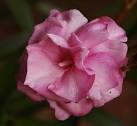 |
| This is Neirum oleander. |
Nerium oleander is an evergreen shrub or small tree in the dogbane family Apocynaceae, toxic in all its parts. It is the only species currently classified in the genus
Nerium. It is most commonly known as
oleander, from its superficial resemblance to the unrelated olive
Olea, but has many other names.
It is so widely cultivated that no precise region of origin has been
identified, though southwest Asia has been suggested. The ancient city
of Volubilis
in Morocco took its name from the old Latin name for the flower.
Oleander is one of the most poisonous of commonly grown garden plants.
Description
A seed capsule spreading seeds
Oleander grows to 2–6 m (6.6–20 ft) tall, with erect stems that splay
outward as they mature; first-year stems have a glaucous bloom, while
mature stems have a grayish bark. The leaves
are in pairs or whorls of three, thick and leathery, dark-green, narrow
lanceolate, 5–21 cm (2.0–8.3 in) long and 1–3.5 cm (0.39–1.4 in) broad,
and with an entire margin. The flowers grow in clusters at the end of each branch; they are white, pink to red,
2.5–5 cm (0.98–2.0 in) diameter, with a deeply 5-lobed fringed corolla
round the central corolla tube. They are often, but not always,
sweet-scented.
The fruit is a long narrow capsule 5–23 cm (2.0–9.1 in) long, which splits open at maturity to release numerous downy seeds.
Information taken from
www.en.wikipedia.org.
Description pic taken from wikipedia.
Neirum oleander picture from
https://www.google.mv/search?q=nerium+oleander&hl=en&biw=1760&bih=893&tbm=isch&prmd=imvns&ei=CKjmT8rtEM24iAeQrdFZ&start=0&sa=N
You can print it out with Microsoft Word, and give to a friend who does not have a computer too ( as a warning )!!!

No comments:
Post a Comment